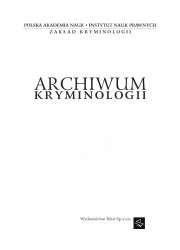Środowisko – przestrzenne uwarunkowania przestępczości
Environmental and Spatial Conditions of Crime
(Selected Problems of Modern Ecology of Crime)
Author(s): Anna KossowskaSubject(s): Law, Constitution, Jurisprudence
Published by: Instytut Nauk Prawnych PAN
Keywords: environmental;spatial conditions;crime;modern ecology of crime;
Summary/Abstract: The modern criminologists who deal with environmental aspects of crime stress the fact that for an offence – a definite criminal act – to occur, four elements must necessarily coincide: law, perpetrator, object, and place of crime. The modern environmental criminologists are interested in the fourth of these elements, that is the spatial aspect of crime. Discussed in the paper have been the main trends of the modern study of spatial conditions of crime. Unlike the former ecologists of crime, the modern researchers are interested not only in the actual place where the offence was committed or the perpetrator resides, but also – to a much grester extent – in the social and physical features of the place of crime, in the actions that should be undertaken to reduce the “susceptibility to crime” of a given ecological unit, and in the course and consequences of the process of ecological stigmatization of a given region. On of the main trends of modern ecology of crime is analysis of the relations between functions and features of the of the separate fragments of urban space on the one hand, and the extent of crime in that area on the other hand. The basic difference between the discussed trend and the former traditional ecological thought born in the Chicago school of criminolology consists in the latter’s attempts at finding the causes of spatial differentiation of the extent of crime in the combination of sociodemographic factors, architecture, and town-planning. Thus also the factors related to a town’s physical structure are taken into consideration. As has been found in many recent studies, the different crime indices found in the separate urban neighbourhoods are related to those areas’ different functions, social features, and architecture. Another interesting trend is analysis of the process of change within clearly delimited neighbourhoods. The term generally used in this connection is a neighbourhood’s “career in crime”; its sense is identical to that of “career in crime” of an individual which can be found in criminological works. According to British and American authors, changes, in a neighbourhood’s nature can be related e.g. to changing housing policy which obviously influences the shaping of definite human communities in given areas. The social situation in neighbourhoods submitted to formal housing policy is thought to be particularly entangled. This results from the nature of that policy: applied to the population characterized by pent up social problems, it usually consisted in placing large numbers of similar families in one rather small area. Thus individual problem families added up to form agglomerations of problem groups of the population. The problem of careers in crime of housing districts is related to another important trend in the modern study of environmental conditions of urban crime: the functioning of informal social control which many consider to be as important a factor of urban crime prevention as the official control. Informal control is also thought to influence the oscial perception of disorder in housing districts. Concerned here is accumulation in a given neighbourhood of external symptoms of social disorganization, that is all the events that might be found – by the locals and strangers alike – to manifest the breakdown of the accepted norms of behavior in urban environment. Analysed is the process of transition from such external symptoms of disorder to crime in a given neighbourhood. Two direct effects are distinguished of occurrence in a neighbourhood of noticeable symptoms of disorder, perceived by the locals as well as strangers. On such effect is the offenders’ conviction as to inefficient (formal and informal) control, in the neighbourhood, which makes criminal activity relatively safe. The other effect consists in some inhabitants’ reluctance to participate in the local life. Their withdrawal from such life results in a distinct breakdown of informal social control, and sometimes in noticeable decline of the neighbourhood which often proves irreversible. Another trend – relatively novel and no doubt characteristic of modern ecology of crime – investigates the impact of architecture of a town or district on crime found in that neighbourhood. On of the currents here, derived from the tradition of situational crime prevention, argues that the actual architecture of the housing districts and other elements of urban space can influence crime, that is facilitate or hamper offences. According to the other current, definite architecture can release deviant and criminal conduct as tenants of the popular large apartment houses feel anonymous and uncontrolled by others. Study of the ways offenders perceive towns, and of their related decisions as to commission of definite acts, is the last of the discussed trends of modern ecology of crime. The related problem here is offenders’ mobility and the distance between their place of residence and locus delicti. Offenders have been found to choose definite objects guided by their belief as to the value, visibility and accessibility of those objects, by transport facilities, and by the apparent presence or absence of supervision on part of the police or other users of the urban space.
Journal: Archiwum Kryminologii
- Issue Year: 1993
- Issue No: XIX
- Page Range: 7-16
- Page Count: 10
- Language: Polish

